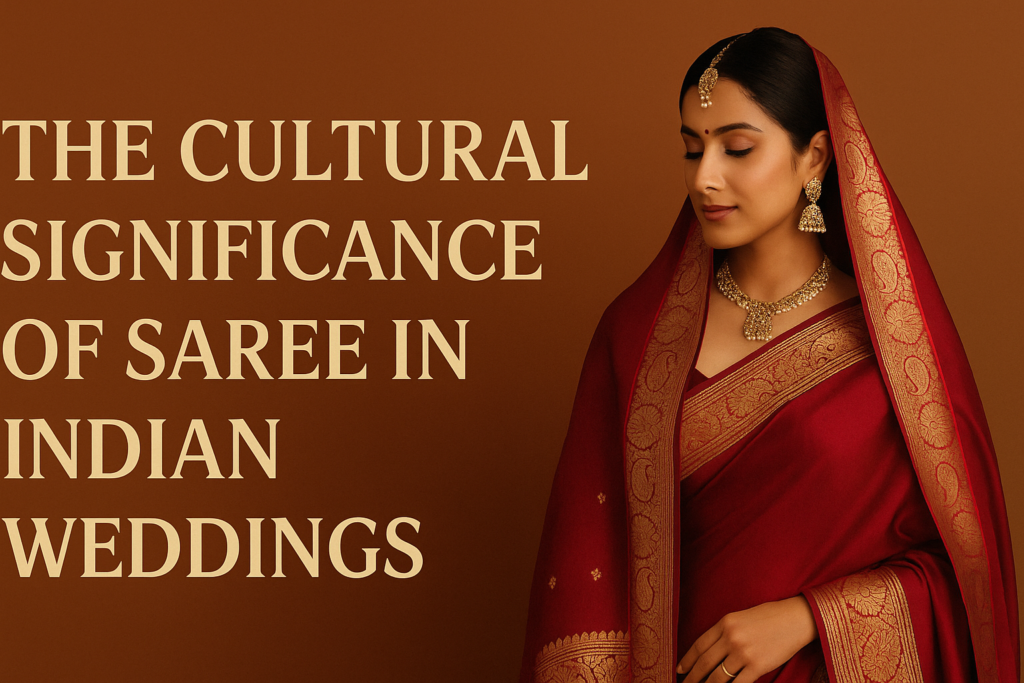
𝗧𝗿𝗮𝗱𝗶𝘁𝗶𝗼𝗻𝗮𝗹 𝗘𝗺𝗯𝗿𝗮𝗰𝗲: 𝗪𝗵𝘆 𝗦𝗮𝗿𝗲𝗲𝘀 𝗔𝗿𝗲 𝗖𝗲𝗻𝘁𝗿𝗮𝗹 𝘁𝗼 𝗜𝗻𝗱𝗶𝗮𝗻 𝗪𝗲𝗱𝗱𝗶𝗻𝗴𝘀
The saree is more than just fabric—it is a powerful symbol of Indian heritage. Especially in weddings, the saree holds deep emotional, spiritual, and cultural meaning. From North to South India, bridal sarees are chosen with great care, aligning with family traditions and religious customs.
—
𝗦𝗮𝗿𝗲𝗲 𝗶𝗻 𝗛𝗶𝗻𝗱𝘂 𝗪𝗲𝗱𝗱𝗶𝗻𝗴𝘀 – 𝗔 𝗦𝗮𝗰𝗿𝗲𝗱 𝗦𝘆𝗺𝗯𝗼𝗹
In Hindu weddings, the bride traditionally wears a saree—often red or maroon—signifying fertility, prosperity, and marital bliss. The saree is often gifted by the groom’s family or the bride’s mother as a sacred blessing. The pallu is sometimes used during rituals like the “Gathbandhan,” where it is tied to the groom’s attire to symbolize union.
—
𝗧𝗿𝗮𝗱𝗶𝘁𝗶𝗼𝗻𝗮𝗹 𝗪𝗲𝗱𝗱𝗶𝗻𝗴 𝗦𝗮𝗿𝗲𝗲 𝗩𝗮𝗿𝗶𝗲𝘁𝗶𝗲𝘀 𝗔𝗰𝗿𝗼𝘀𝘀 𝗜𝗻𝗱𝗶𝗮
Each state has its own wedding saree traditions:
- 𝗞𝗮𝗻𝗷𝗶𝘃𝗮𝗿𝗮𝗺 (Tamil Nadu): Known for its temple motifs and heavy zari.
- 𝗕𝗮𝗻𝗮𝗿𝗮𝘀𝗶 (Uttar Pradesh): Popular for Mughal-inspired brocade work.
- 𝗣𝗮𝗶𝘁𝗵𝗮𝗻𝗶 (Maharashtra): Features colorful silk and peacock motifs.
- 𝗣𝗮𝘁𝗮𝗹𝗮 𝗦𝗮𝗿𝗲𝗲 (Gujarat): Usually worn during post-wedding functions.
- 𝗠𝘂𝗴𝗮 𝗦𝗶𝗹𝗸 (Assam): Preferred in Assamese weddings for its natural sheen.
—
𝗧𝗵𝗲 𝗘𝗺𝗼𝘁𝗶𝗼𝗻𝗮𝗹 𝗩𝗮𝗹𝘂𝗲 𝗼𝗳 𝗮 𝗕𝗿𝗶𝗱𝗮𝗹 𝗦𝗮𝗿𝗲𝗲
Many women preserve their wedding saree for life. It becomes a cherished heirloom passed down through generations. This emotional connection is one of the most beautiful parts of Indian bridal culture.
—
𝗠𝗼𝗱𝗲𝗿𝗻 𝗧𝗿𝗲𝗻𝗱𝘀: 𝗖𝗼𝗺𝗯𝗶𝗻𝗶𝗻𝗴 𝗧𝗿𝗮𝗱𝗶𝘁𝗶𝗼𝗻 𝘄𝗶𝘁𝗵 𝗦𝘁𝘆𝗹𝗲
Today’s brides blend traditional sarees with modern cuts, accessories, and makeup. From pre-pleated sarees to belt-style draping, bridal fashion continues to evolve while respecting cultural roots.
—
𝗙𝗶𝗻𝗮𝗹 𝗧𝗵𝗼𝘂𝗴𝗵𝘁𝘀
The saree in Indian weddings isn’t just about beauty—it’s about culture, blessings, and a lifetime of memories. Choosing a wedding saree isn’t just a fashion decision; it’s a spiritual one that connects the bride to centuries of tradition.
